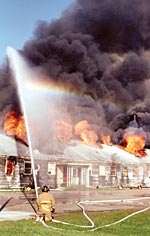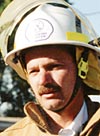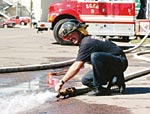A Call to Serve: Today’s Fire Fighters
By Jody Ewing
October 4, 2001
-
 Photos by Jody Ewing
Photos by Jody Ewing - Members of the Sioux City Fire Department participate in a live fire training exercise on Oct. 2 at the old tarp building at Sioux Gateway Airport. The live burn gives probationary personnel more fire fighting experience under controlled conditions.
A 9 a.m. alarm jars Fire Station No. 3 to action. Seven men quickly don coats and boots, and in less than a minute are whirring down 5th Street. The call: from the Story Time Preschool Child Care Center.
When the call turns out to be a false alarm, a collective sigh of relief falls over the group as they head back to the station to commence with daily chores. But it’s not always that easy.
On the ground floor here, the uniforms and hats say it all. Thick yellow coats hang neatly on hooks. Rows of rubber boots, complete with steel toes and shanks, hug the wall beneath the coats. And above the collars hangs a row of black and red hats – looking like a large family’s winter gear. But one thing is very different – an American flag proudly decorates the front of each hat, a reminder of why they are there.
The role of today’s firefighter has never been more apparent than since the recent attack on the World Trade Center, where 343 New York City firefighters lost their lives. It is a loss felt around the world, and no more acutely than in fire stations across the nation where rescuers mourn the loss of one of their own.
“It’s a group of people doing the same job you do, and then suddenly a big number of them are killed,” says Richard Uhl, a 20-year veteran fireman and captain of the No. 3 station. The deaths, he says, affect firefighters in a different sort of way. “It’s a specialized profession. We know what the other guy thinks.”
So as these uniformed men and women go forward, upholding a mission of “preserving life, property, and the environment,” they face new challenges unknown to those who, in 1870, first met to discuss the need for fire protection in Sioux City.
Their unwavering devotion and compassion goes beyond fighting fires or rescuing cats from trees; it harbors a basic foundation of trust on which many lives depend. And much of that trust is built on education.
As “National Fire Prevention Week” kicks off Oct. 7, Uhl and his fellow firefighters will be doing one thing they do best: informing adults and children of the dangers and safety tips they face when fighting fires. By giving their bi-annual presentation, they hope to offer a glimpse of today’s firefighter and perhaps save a few lives in the process.
Prepared for a Risky Task
The success of a fire department is contingent upon many things, namely its personnel, its readiness, and the sophistication of its protective and firefighting gear.
In Sioux City, 114 uniformed personnel, including two women and four civilian employees, take on the role that is often dangerous, but never ordinary. Together they provide services from seven separate stations. There are seven engine companies, two truck companies, one command vehicle and a host of specially designed vehicles with equipment such as the Jaws of Life and pneumatic air bags. Two engines and one truck are kept in reserve as backup.
“Engine Number 3 is brand new, less than a month old,” says Rusty Soole, a firefighter since 1980 and lieutenant of Station No. 3. The “engine company” truck holds 500 gallons of water and carries 1,775 feet of hose.
The station’s “truck company” carries axes, oxygen tanks and breathing apparatus, and includes a 105-foot aerial ladder. Three officers are assigned to each rig, one of whom must be a captain or lieutenant. The station is normally staffed with a minimum of seven officers.

Covered from head to toe in gear, including fire retardant bunker pants, protective masks and a hood wrap that goes around the neck, officers land at the scene of a fire ready for the worst.
“The men are aptly covered, but dangers still exist when they go in to fight a fire,” says S.C.F.D. training officer James Clark, Jr., a 19-year fire department veteran who coordinates the training programs in Woodbury County and surrounding communities.
“The ‘turn out’ gear is designed to protect for temperatures up to 1000 degrees,” he says. “They’re limited to how much heat they can actually feel because they’re so encapsulated in gear. Flowing water into high temperatures creates steam, which can result in bad burns.”
As additional protection, each firefighter wears a Personal Alarm Safety System with “alert” and “alarm” modes. If the safety system doesn’t detect an officer’s movement within 15 seconds, the system goes to alert, sending signals to other crewmembers.
“Then, you have to push a button to turn it off,” says Uhl. “It signals that a firefighter isn’t moving and might be in trouble.”
Movement is often difficult, Uhl says, when confined to tight spaces or when trying to rescue someone. “You’re in there with heavy clothing and wearing that tank on your back, lugging the hose through the building and trying to drag a person out of the house,” he says. “You couple all that with the heat, and it can be very difficult.”
But with the right skills and understanding of their role, today’s firefighters are prepared for a day in an unusual life.
A Day in the Life
“We’ve received 4,400 calls this year so far,” says Uhl of the entire fire department. “Though we do have more EMS calls than fire. I’m sure we’ll beat the number for 1996.”
In 1996, the department responded to 5001 calls – 1489 fire alarms and 3512 for emergency medical service. The fire department responds to all EMS calls except transports.
 Officer Trent Garritson tests one of the hoses during Station No. 3’s bi-annual testing, which ensures the hoses can withstand a normal test of fire.
Officer Trent Garritson tests one of the hoses during Station No. 3’s bi-annual testing, which ensures the hoses can withstand a normal test of fire.
The ambulance can only get to the areas so fast,” Uhl says. “If the patient had a heart attack and is pulseless, you only have about four minutes to get them started with CPR.”
All structure fires are considered a “four tap district,” where two engines and two trucks respond. Smaller fires require only one rig to respond.
On this day, Station No. 3 is conducting its bi-annual testing of hoses to see if they can withstand the normal test of fire.
“It really depends on the situation,” says Uhl. “Depending on the size of a grass fire, we might take another truck. Every single alarm is different.”
“They have to withstand 250 pounds for five minutes, which will test every length of the hose,” says Soole. The water is shot outside along the curb. The rubber-lined hoses are then cleaned and hung to dry in the station’s hose tower.
It is Friday, which means the station’s slide poles are polished. Station No. 3 is the only remaining fire station in Sioux City that has the infamous copper poles that firefighters use to quickly descend to the first floor. The two-story structure, located at 1211 5th Street, was built in built in 1929 and will be closed next year and relocated to a new building at the corner of 3rd and Fairmount streets. Building efficiency is forcing the move.
“We’re basically the training house,” says Uhl. “When someone first begins, they have 12 months of probation, which is all OJT (on the job training).”
That training includes instruction in hazardous materials (HAZMAT), ladder stacks and using the self-contained breathing apparatus. Newcomers also learn of incident command, fire control, fire investigation and running a pump. For the first four years, officers are considered “floaters,” and alternate between stations, depending on need.
Firefighters reside at the station while on duty, working 24 hours on and 48 hours off. The current sleeping room upstairs houses eight beds, with the truck crew on one side, the engine crew on the other. Boots sit waiting next to the bed so that officers can be out the door within one minute.
“You can go from sleeping soundly in bed, to five minutes later, being inside a burning building fighting a fire,” says Uhl.
At 9:50 a.m., the alarm goes off again. Officers are called to Custom Woodworks, Ltd., where the irony strikes close to home; to the right of the front door is a sign which reads “Butt Stop,” with a container for extinguishing cigarettes.
First Rules of Safety — Sioux City Fire Department Safety Tips
1. Install Smoke Detectors — Smoke detectors should be installed on every level of your home and outside each sleeping area. Test batteries once a month and replace twice a year.
2. Plan Your Escape — Sit down with your family and agree on an escape plan now.
3. Smoking Materials — Don’t Smoke In Bed. Check for smoldering cigarettes before going to bed.
4. Kitchen Safety — Never leave the stove unattended, and keep combustible materials away from the sides of the stove. Be careful with kids playing in the kitchen. If grease catches fire on the stove, cover the pan with a lid and turn the burner off – NEVER put water on a grease fire.
5. Space Heaters and Fireplaces — Keep at least three feet away from all combustible material. Clean fireplace chimneys and flues at the beginning of each heating season.
6. Match and Lighter Safety — Teach children that matches and lighters are TOOLS, not TOYS, to be used only with adult supervision.
7. Crawl Low Under Smoke — In a fire, smoke and poisonous gases rise to the ceiling with heat. To escape through a smoky atmosphere, crawl low under the smoke.
8. Stop, Drop, and Roll — If your clothes catch fire, don’t run. Stop where you are, drop to the ground, cover your face with your hands and roll over and over to smother the flames.
9. Fire Fighting — If you have a fire, get out and stay out and call 911.
10. Carbon Monoxide — Equip your home with a carbon monoxide detector.
Assistant fire chief Jim Diamond from Station No. 1 arrives at the scene. His presence is required at all two-alarm fires, and he is referred to as “Car 19.” Although there is no fire, Diamond says there’s a difference between that and a false alarm.
“Dust can set off the system,” he says, “and that may trigger an alarm. But sometimes you get there and there’s no smoke or dust.”
In 50 percent of fires, an investigation is required to determine how it started. When the cause isn’t readily clear or there are suspicious circumstances, the fire marshall and two other inspectors will investigate the evidence. Yet firefighters agree on the major cause of fires.
“Smoking paraphernalia and kids playing with matches,” says Uhl, citing the two most common fire hazards.
Among a litany of other jobs, fire crews inspect new and existing businesses, noting potential fire hazards, location of windows and exits, and types of materials used in construction. Every business is inspected at least once a year, and some – such as grain mills and day care centers – get specialized inspections more often.
Officers head out after lunch to tour the newly renovated Plymouth Block Building on Historic 4th Street. The structure will open soon and house apartments and retail shops. Officers comb the building from basement to roof, examining doors and open areas. They take note of cupboards, carpet and ceilings much differently than a tenant who might be moving in.
Lieutenant Chuck Hirsh, an arson investigator and fire prevention specialist, informs the touring officers of the building’s new “Intelligent Fire Detection and Alarm System,” and explains the operation of the module inside the front door. “It will tell why the alarm went off and where the problem is,” Hirsh says.
Though every fire is different, Uhl says the biggest risk to firefighters is the collapse of a building while working inside. Such was the case in 1982 at a fire he describes as the worst he’s seen.
“We had two firemen who died,” Uhl says of the poultry processing plant whose floor eventually collapsed, killing co-workers Kirk Wicker and Mike Johnson.
“Kirk was only about 25 years old and had just recently gotten married,” Uhl says. “Mike was married and had two kids. It was tough.”
Wicker’s wife donated seven matching swivel chairs to Station No. 3’s kitchen, each containing a nameplate inscribed in memory of her late husband.
Clyde Newton, a 28-year-veteran, said his worst fire was more than 20 years ago on Silver Street when five children perished in a fire on Christmas Eve. The hardest ones to forget, he says, are those involving children.
“A lot of our rescues aren’t big and dramatic,” says Uhl of the typical fire. “Or, we might get there and get somebody out. Sometimes if a patient is in cardiac arrest we’ll defibrillate them. And sometimes, people follow up, calling and thanking us and letting us know they made it okay. It’s a good feeling to help anybody to any degree.”
Keeping Up With Training, Education
With winter fast approaching, the potential for fires increases as wood burning stoves are fired up and dormant furnaces are brought back to life. During National Fire Prevention Week, firefighters share their knowledge by delivering fire and safety educational programs throughout Siouxland.
“We do this twice a year,” says Soole, “and have an open house at all the fire stations.” In addition to public education, ongoing training for officers is part of the firefighting life. This week, the old tarp building at the Sioux Gateway Airport was burned down in an awesome live fire-training exercise.
The live fire burns give probationary personnel more fire-fighting experience under controlled conditions, and are fought in a “defensive” mode from outside the structure.
There is monthly training at the department’s 18th Street “tower,” where officers practice stacking ladders and train for high-angle rescues.
In addition, the department continually reviews its policies, and in the past two years made a change that requires all applicants to be certified in basic EMS.
“They don’t have to have any fire-fighting experience before they come on board, but they do have to have an EMS-B,” says Clark. Applicants apply through Civil Service, and are required to complete a written, oral and civil service exam.
Though firefighters take pride in serving their communities, none like to witness preventable fires. The best way to prevent them?
“Talk to kids,” says Uhl. “And if you’re a smoker, take care of the butts. Common sense will take you a long way in fire safety.”
For more Information, visit the S.C.F.D. website or call (712) 279-6314.
Leave a Reply